Princess Philippine Charlotte of Prussia (13 March 1716, in Berlin – 17 February 1801, in Brunswick) was Duchess of Brunswick-Wolfenbüttel by marriage to Duke Charles I. Philippine Charlotte was a known intellectual in contemporary Germany. She is listed as a female composer as she is thought to have written marches and other music.
Philippine Charlotte was the fourth child and third daughter of Frederick William I of Prussia and his spouse Sophia Dorothea of Hanover (those who reached adulthood; she was otherwise seventh child and fourth daughter).
On 2 July 1733 in Berlin, Princess Philippine Charlotte married Duke Charles of Brunswick-Wolfenbüttel, eldest son of Ferdinand Albert II, Duke of Brunswick-Wolfenbüttel. Charles inherited the dukedom on his father's death in 1735, making her Duchess consort.
The double marriage alliance between Prussia and Brunswick by her marriage to Charles I, and that of her brother Frederick to Charles' sister Elisabeth Christine, led to a permanent alliance of the most important North German Protestant houses in Prussia and Brunswick.[1] The family ties of the two dynasties resulted in the alliance of Brunswick and Prussia in the Seven Years' War, and the career of Philippine's sons in the Prussian service.[2]
Philippine Charlotte was described as subtle, highly educated and a child of the Age of Enlightenment.[3] She worked independently of an extract of the philosophical writings of Christian von Wolff in French.[4]
The Duchess pursued, partly because of the influence of the ducal adviser Johann Friedrich Wilhelm Jerusalem, the German intellectual life very closely. She appreciated the poet Salomon Gessner and maintained a personal relationship Friedrich Gottlieb Klopstock.[5] The dramatist Gotthold Ephraim Lessing was also among her circle.[6]

As Duchess consort, Philippine Charlotte's court life focused on the circle of conversation she held before and after dinner in her state apartments in the Grauer Hof, to which she attracted scholars and men of letters with positions at court.[7] The Brunswick court attended a few opera performances and public balls a year in accordance with court etiquette, but the large expenditure of her spouse soon made it necessary to have a more economic court life.[8]
| Prussian Royalty |
| House of Hohenzollern |
|---|
 |
| Frederick William I |
|

She raised her son Charles in reverence of her brother Frederick, gave him a humanist education with Abbé Jerusalem among his tutors, and sent him on a Grand Tour with the archaeologist Johann Joachim Winckelmann as his companion.[9]
In 1773, Charles I was obliged to make his son regent, and in 1780, he died, and was succeeded by her son.
The Swedish Princess Hedwig Elizabeth Charlotte described her, as well as her family, at the time of a visit in August, 1799:
Our cousin, the Duke, arrived immediately the next morning. [...] After he left us, I visited the Dowager Duchess, the aunt of my consort. She is an agreeable, highly educated and well respected lady, but by now so old that she has almost lost her memory.[10]

Philippine Charlotte left to the Wolfenbüttel Library her own collection of 4,000 volumes.
She is buried in Braunschweig Cathedral.
Two paintings now in the Wittum Palace in Weimar depict Philippine Charlotte with her little dog next to a harpsichord – a style later adopted for a portrait of her daughter Anna Amalia, located in the same place. A fireplace screen embroidered by the Duchess is located in the concert room of the New Palace in Potsdam.[11]
| Issue | |||
|---|---|---|---|
| Name | Portrait | Lifespan | Notes |
| Charles II Duke of Brunswick-Wolfenbüttel |

|
9 October 1735- 16 October 1806 |
Married Princess Augusta of Great Britain, had issue |
| Georg Franz |
29 September 1736- 10 December 1737 |
Died in infancy | |
| Sophie Caroline Marie Margravine of Brandenburg-Bayreuth |

|
7 October 1737- 21 December 1817 |
Married Frederick, Margrave of Brandenburg-Bayreuth and had no issue |
| Christian Ludwig |
13 November 1738- 12 April 1742 |
Died in childhood | |
| Anna Amalia Duchess of Saxe-Weimar and Eisenach |

|
24 October 1739- 10 April 1807 |
Married Ernest Augustus II, Duke of Saxe-Weimar-Eisenach and had issue |
| Frederick Augustus |

|
29 October 1740- 8 October 1805 |
Married Princess Friederike Sophie Charlotte Auguste of Württemberg-Oels and had no issue |
| Albrecht Heinrich |

|
26 February 1742- 8 August 1761 |
Died unmarried; |
| Luise |
18 December 1743- 22 February 1744 |
Died in infancy | |
| Wilhelm Adolf |
18 May 1745- 24 August 1770 |
Died unmarried; | |
| Elisabeth Christine Crown Princess of Prussia |

|
8 November 1746- 18 February 1840 |
Married Frederick William, Crown Prince of Prussia and had issue
The marriage was dissolved in 1769 |
| Friederike |
8 April 1748- 22 January 1758 |
Died in childhood | |
| Augusta Dorothea Abbess of Gandersheim |

|
2 October 1749- 10 March 1810 |
|
| Maximilian Julius Leopold |

|
11 October 1752- 24 April 1785 |
Died unmarried |
| Ancestors of Princess Philippine Charlotte of Prussia[12] | |||||||||||||||||||||||||||||||||||||||||||||||||||||||||||||||||||||||||||||||||||||||||||||||||||||||||||||||||||||||||||||||||||||||||||||||||||||||||||||||||||||||||||||||||||||||||||||||||||||||||||||||||||||||||||||||||||||||||||||||||||||||||||||||||||||||||||||||||||||||||
|---|---|---|---|---|---|---|---|---|---|---|---|---|---|---|---|---|---|---|---|---|---|---|---|---|---|---|---|---|---|---|---|---|---|---|---|---|---|---|---|---|---|---|---|---|---|---|---|---|---|---|---|---|---|---|---|---|---|---|---|---|---|---|---|---|---|---|---|---|---|---|---|---|---|---|---|---|---|---|---|---|---|---|---|---|---|---|---|---|---|---|---|---|---|---|---|---|---|---|---|---|---|---|---|---|---|---|---|---|---|---|---|---|---|---|---|---|---|---|---|---|---|---|---|---|---|---|---|---|---|---|---|---|---|---|---|---|---|---|---|---|---|---|---|---|---|---|---|---|---|---|---|---|---|---|---|---|---|---|---|---|---|---|---|---|---|---|---|---|---|---|---|---|---|---|---|---|---|---|---|---|---|---|---|---|---|---|---|---|---|---|---|---|---|---|---|---|---|---|---|---|---|---|---|---|---|---|---|---|---|---|---|---|---|---|---|---|---|---|---|---|---|---|---|---|---|---|---|---|---|---|---|---|---|---|---|---|---|---|---|---|---|---|---|---|---|---|---|---|---|---|---|---|---|---|---|---|---|---|---|---|---|---|---|---|---|---|---|---|---|---|---|---|---|---|---|---|---|---|---|---|---|
| |||||||||||||||||||||||||||||||||||||||||||||||||||||||||||||||||||||||||||||||||||||||||||||||||||||||||||||||||||||||||||||||||||||||||||||||||||||||||||||||||||||||||||||||||||||||||||||||||||||||||||||||||||||||||||||||||||||||||||||||||||||||||||||||||||||||||||||||||||||||||
Media related to Princess Philippine Charlotte of Prussia at Wikimedia Commons